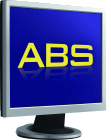| www.AmericanBusinessSoftware.com | Login | | | | | Home |

|
American Business Software, Inc. |
|
|
|
|
||||||||||||||||||||||||
As the cost of bar coding technology continues to decrease, you no longer need to be a large corporation to see a return on an investment in bar coding technology. Many people assume that the degree of your cost savings depends on how many of your products are received with bar coding labels already on the products. While it's true that your direct cost of bar coding is reduced when your suppliers bar code their products, there are many other intangible cost savings to consider as well. By using bar coding for receiving, items are entered into inventory quicker and with more accurate bin locations. Using bar coding for shipping lets you know if any order or even an item on one order had "missed the truck". Cyclic inventory checks are quicker and less costly, giving you a more accurate inventory count. In an ideal situation, a supplier will bar code the products and send an advance copy of the shipping manifest. If the manufacturer does not bar code the product (many off shore suppliers do not bar code), simply receiving advance copies of the receiving manifest from your suppliers can help. These manifests can be electronic (EDI), e-mail (text), fax, or even verbal confirmations. By knowing what items are in the shipping container, you can still have the benefits of seamless integrated receiving. Receiving ProcessPrior to receiving a shipment, the Receiving Manifest is input into the system. This information can come from an electronic document, any advance document, an open purchase order, or even the manifest at the receiving dock. This process matches the items you are receiving with your outstanding purchase orders. The system produces a "Put Away List". Each item on the manifest is listed, along with the associated bar code. If the vendor does not bar code the product, then bar code labels are printed and affixed to the goods prior to being stored in the warehouse. When the supplier does not bar code, but does palletize (such as off shore ceramic tile), typically individual products are not labeled. In this case, two labels are placed near the bottom of the pallet. When inventory is received at the dock, if the product is already bar coded, the product is scanned. For products with no bar code, the "Put Away" list is scanned. The bar code unit displays the quantity from the manifest asks the user to verify that it matches the quantity received. If need be, pallet labels or other item labels are printed which are affixed to the product. A Receiving Exception Report shows discrepancies between the manifest and what was actually received. The bar code receiving process automatically updates the bin location in the computer system, thus eliminating the extra step of manually entering the location. When inventory is moved from one bin location to another, the transport program automatically updates the bin location as it is moved. This reduces the number of "cannot find" errors and increases shipment reliability, thus improving customer service. Shipping ProcessWarehouse picking tickets are printed with bar codes and bin locations. When the warehouse picks an order, they scan the picking ticket, the item(s) and the staging area. In the event the material is not in the expected bin location, alternate bin locations can be displayed on the bar code unit. In the event the material is "short" or "cannot find", customer service is notified and a decision to either "short ship" or to "not ship" the line item is made. This bar coding process can work in conjunction with the FloorPro® III Truck Routing system. As the shipping "cut off" time approaches, routes can be easily adjusted based on geography and expected delivery dates. Manifests can be printed in the reverse "stop number" order. The "stop number" is the sequence in which the orders are normally delivered to the customer. Shipping labels are printed and then scanned when the items are moved onto the truck. The system verifies that the items are moved to the correct truck by comparing it to the orders on a shipping manifest. A Shipping Exception Report displays items, which should be on the truck but were not scanned as being moved onto the truck. If, for some reason, the item was removed from the truck, and "left standing on the dock", the order information and route can be determined by scanning the shipping label. Inventory CountsPhysical inventory and cyclic inventory counts are simpler and less time consuming when products are bar coded. A physical inventory assumes all items in the warehouse will be counted whereas a cyclic inventory count assumes only a certain range of bin locations will be checked at a given time. The system records the product and quantity information for each item scanned. When the count is complete, the system reports the differences between what the system believes to be in inventory versus what was actually counted. Discrepancies of this sort generally require another count to ensure that the inventory is really not on hand. For cyclic counts, inventory which is not found can be added to the "looking for" bin location since it might actually be in the warehouse in another bin location, which was not part of the cyclic inventory count. [1] The Ready for IBM Technology Mark and the trademarks contained therein are trademarks of IBM Corp. IBM is not the licensor of this Business Partner's product and does not make any warranties regarding this Business Partner's product. |
||||
|
Copyright© 2010 - 2023 American Business Software, Inc. FloorPro® is a Registered Trademark of American Business Software, Inc. |
Home | Company | Products | Partners | Contacts |
 [1]
[1]